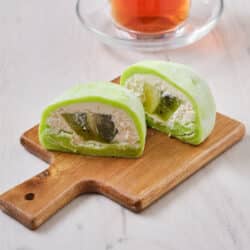As someone who enjoys mochi, I've wondered how to keep it from drying or hardening. Many people have the same question because a quick Google search brings up conflicting answers. Some say you should keep mochi in the fridge; others say you should freeze it. But what's the right solution? After some experimentation, I like to share my findings on how to store mochi. Spoiler alert: it depends on the type of mochi! Keep reading to find out more.
So, how do you store mochi? You can freeze mochi for later use, but it needs to be stored properly to maintain its quality. This article explains how to store mochi, so it doesn't get hard, and I will share some tips on keeping it fresh for as long as possible!
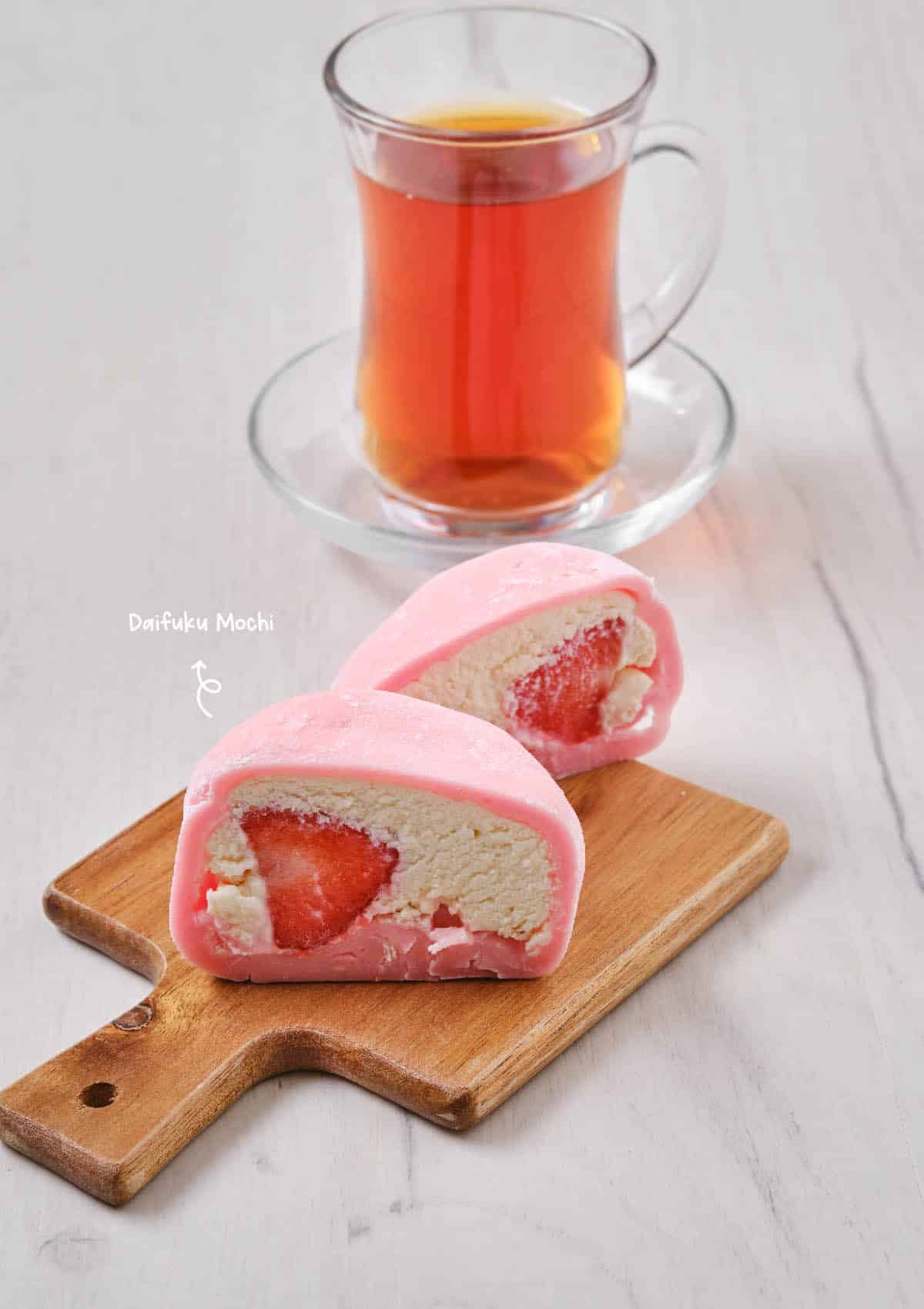
What's the difference between mochi, Dango, and Daifuku?
I want to discuss a topic that most confused me in Japan: Mochi vs. Dango vs. Daifuku. Before coming to Japan, I had heard of mochi and assumed all things that looked like Mochi were Mochi, an erroneous assumption. As it turns out, there are some important differences to know!
In light of this, let me save you from making the same mistake I made and confusing Mochi with Dango and Daifuku - since they are not the same! My memory tells me they all looked the same, so let's go over them one by one.
Let's start by talking about mochi since it's the most well-known among this trio.
What is mochi?
Mochi is made of Mochigome (糯米), a type of short-grain, japonica glutinous rice that is ground, steamed, and pounded sticky. As a result, it has a chewy texture and is usually white, although you can add colors to it.
In Japan, Mochi usually refers to plain mochi - the kind you find in supermarkets or freshly made. The traditional method of making it is mochitsuki, which involves pounding steamed sweet rice with a wooden mallet. While mochi has no flavor, you can use additives to make it sweet.
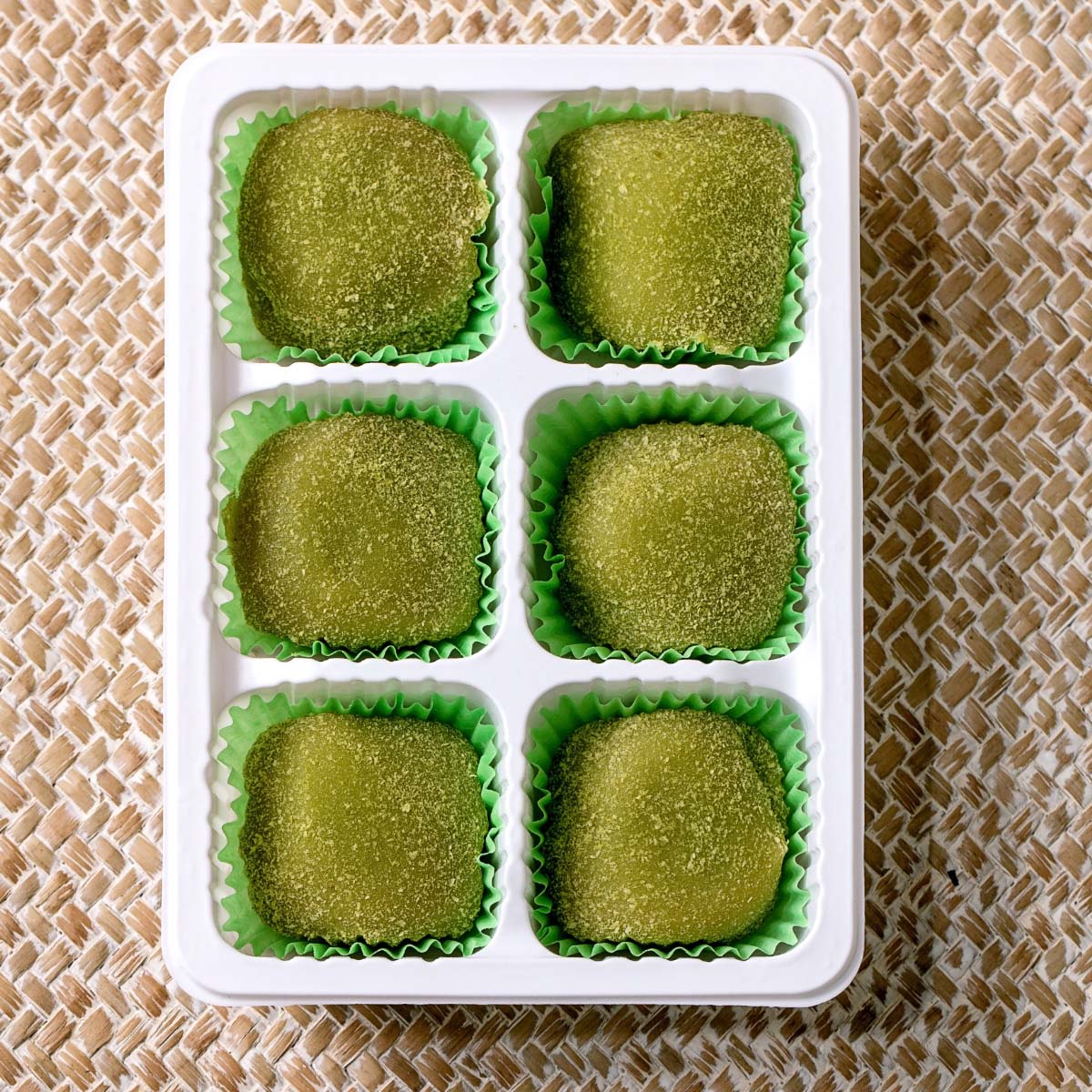
What is Dango?
Dango is made from rice flour (mochiko) instead of whole glutinous rice, usually white in color. It has a much denser and less chewy texture than mochi. Dango is also not naturally sweet but can be flavored with various ingredients to make it a sweet snack or dessert. It often serves as 3-4 round balls (Dango) on a skewer.
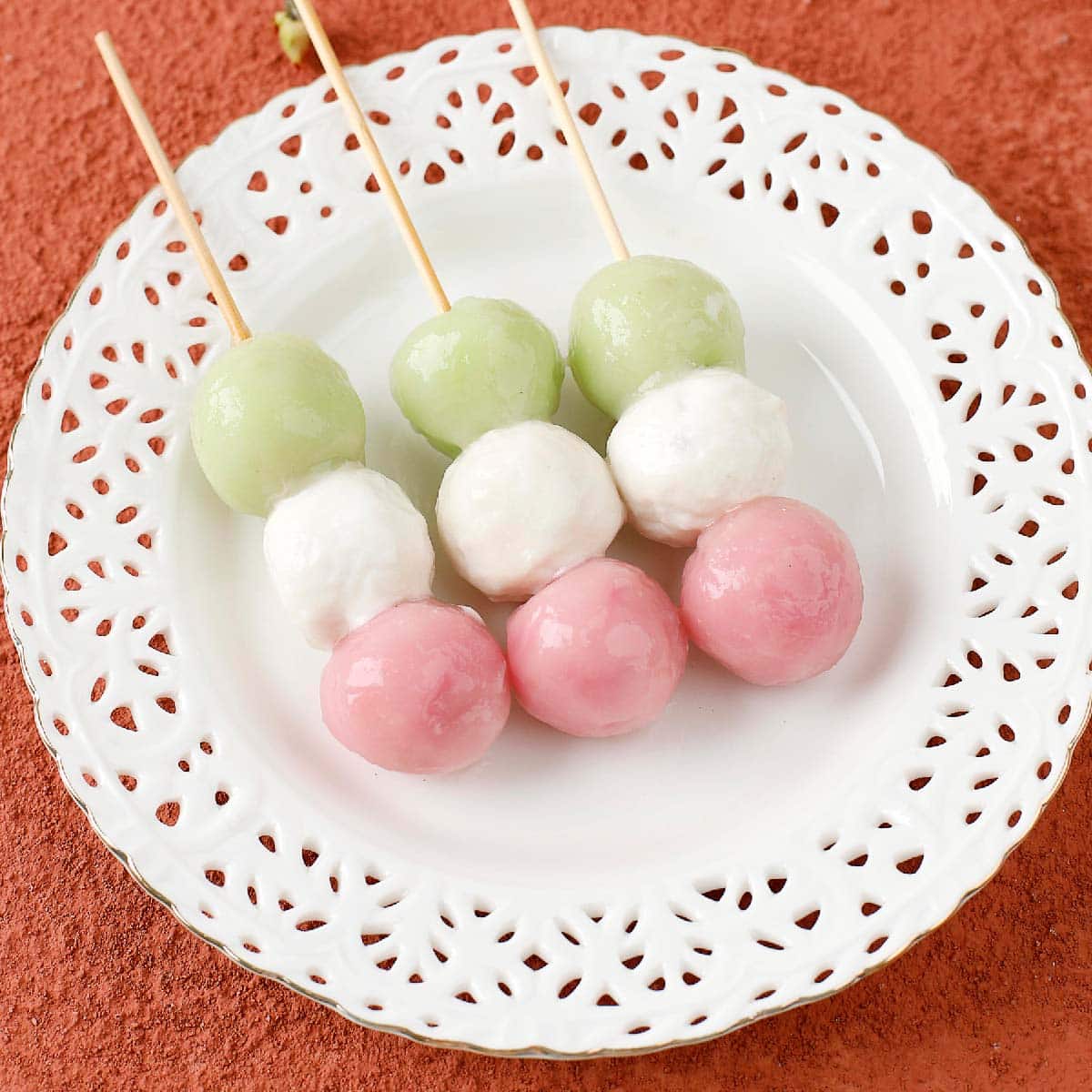
What is Daifuku?
Finally, Daifuku is a type of mochi filled with a sweet filling like red bean paste or ice cream. It has the same chewy texture as mochi and comes in various flavors. It has the same chewy texture and white color as regular mochi, but because of the filling, it is much sweeter and heavier. The chewiness of mochi combined with the sweetness of Anko is delicious.
Examining their texture is the most important aspect of differentiating mochi, Dango, and Daifuku. Mochi has a chewy texture, Dango is denser and firmer, and Daifuku is smooth and creamy due to the filling. All three Japanese snacks and desserts are delicious treats you can enjoy in various ways. They each have their unique textures, flavors, and ingredients, making them all distinct in their own right.
Watch the youtube here on how to make mochi.
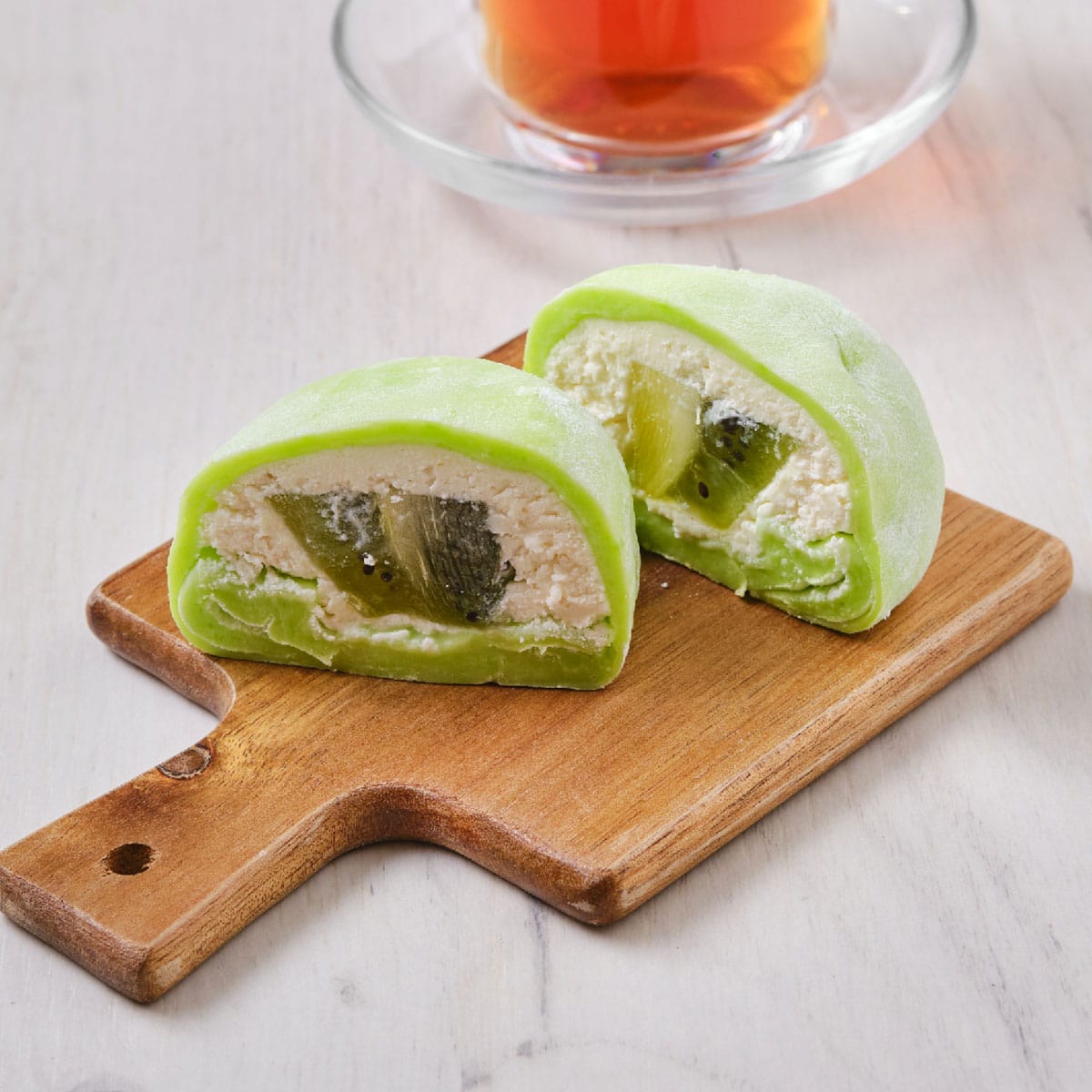
Why is mochi chewy?
Mochi's chewy texture comes from the high content of amylopectin, a type of starch found in glutinous rice. When cooked, amylopectin gelatinizes, causing mochi to become chewy. Mixing the cooked and pounded sticky rice with sugar and other ingredients makes it a soft dough you can form into any shape you like. The combination of moisture and heat makes mochi chewy and slightly elastic.
Mochi can be enjoyed as a snack or dessert and used in recipes such as mochi ice cream, cakes, steamed buns, soups, and more. Whatever the method of serving, mochi will always have its signature chewy texture, making it enjoyable to eat.
Read:
What are the different flavors of Japanese Mochi?
In Japan, there are a variety of mochi recipes that vary from region to region. The most common types are Anko Mochi, Kinako Mochi, and Isobeyaki.
1 Anko mochi (餡子餅).
Anko mochi is a type of mochi which is filled with red bean paste, known as Anko. It has a sweet and chewy texture. The filling of Anko adds a hint of sweetness to the mochi, making it a delicious treat. Why choose Anko mochi? Anko mochi is perfect for anyone who loves a sweet and savory treat. You can enjoy it as an afternoon snack, dessert, or even a small gift.
2 Kinako mochi (きな粉餅).
Kinako Mochi is a classic sweet made from sticky rice and coated with kinako (roasted soybean flour) and sugar. It has a light and fluffy texture with a delicious sweet taste. The kinako gives the mochi a nutty flavor, while the sugar adds sweetness. This traditional sweet is a favorite among many Japanese people and is available in grocery stores, convenience stores, and even at festivals all over Japan.
3 Isobeyaki (磯辺焼き).
What is Isobeyaki mochi? The outside of this type of mochi is coated with soy sauce and sugar and wrapped with nori seaweed. The addition of nori seaweed gives the mochi an extra layer of flavor. This type of mochi is prevalent in Japan and on the menus of many restaurants.
Unlike Anko Mochi and Kinako Mochi, isobeyaki does not contain additional sweeteners like sugar. For those seeking something savory, this makes it a great choice. The mochi is also incredibly versatile, as it can be eaten as an accompaniment to a meal or enjoyed as a snack. Whatever the occasion, Isobeyaki mochi is sure to be a hit!
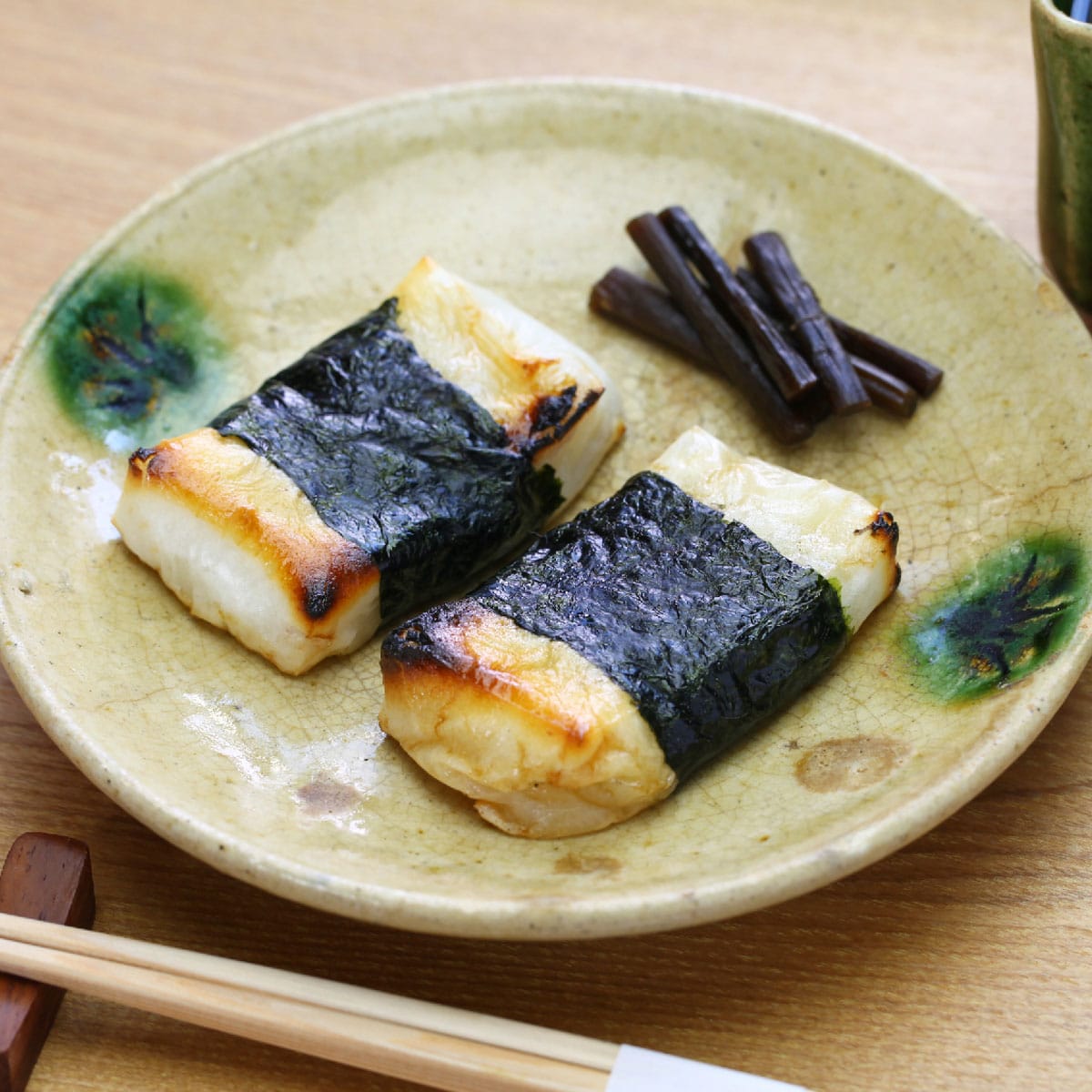
In addition to these three types of mochi, there are other regional variations throughout Japan. These regional mochi recipes often include a variety of ingredients, such as walnuts, chestnuts, sesame seeds, and more.
No matter where you go in Japan, you're sure to find a unique mochi recipe that represents the regional culture and ingredients. So, if you ever have the chance to visit Japan, take some time to explore the different types of mochi and enjoy the unique flavors and textures each one offers.
How to store mochi (the right way)
There are three ways to store mochi: at room temperature, in the fridge, or the freezer.
1 When leaving mochi at room temperature.
If you plan to consume your mochi for a day or two, you can store it at room temperature. Ensure the mochi is covered to preserve its softness and kept out of direct sunlight and heat.
Why is it necessary to cover mochi with plastic wrap or foil?
Covering mochi with plastic wrap or foil is necessary to keep the rice cakes from drying and stale. The airtight wrapping also prevents mochi from absorbing too much moisture, especially if it is humid where you live. Additionally, covering mochi in plastic wrap or foil can help prevent the growth of mold and bacteria on the surface of the rice cakes. This is especially important if you plan to store mochi for an extended period.
Covering mochi with plastic wrap or foil can keep your homemade treats as fresh and delicious as possible. Be sure to seal the wrapping tightly so that no air or moisture gets in. By doing so, you'll be able to keep your mochi as soft and chewy as possible.
Note:
If humidity levels are high, mochi can go rancid quickly, so you may want to store them in the fridge in this case.
2 Keeping mochi in the fridge.
When storing mochi in the fridge, wrap them tightly in cling film and seal them in an airtight container. This way, mochi can be stored for a maximum of seven days. But remember, the longer you keep it, the more it will dry out and lose its freshness.
What happens when you store mochi in the fridge?
Starch molecules in mochi start to retrograde when stored in the fridge due to the cold temperatures. After exposure to cold temperatures, it loses its structure and becomes a gel-like substance. This process of starch becoming gel-like is called retrogradation and leads to the chewy texture of mochi after it has been refrigerated.
During retrogradation, the starch molecules form hydrogen bonds and bond together, resulting in the chewy texture of the mochi. The colder the temperature, the faster this process will occur, so storing mochi in the fridge can cause rapid retrogradation and lead to a tough texture. It's best to store mochi at room temperature to avoid this phenomenon. Freezing is the best option unless you plan to eat the mochi immediately.
Read:
Why is wrapping mochi in a cling film vital when storing it in the fridge?
Storing mochi in the fridge is a great way to keep them longer. Wrapping the mochi tightly in cling film and storing them in an airtight container will keep them from absorbing unwanted odors, moisture, and bacteria from other food items. It also prevents drying out by limiting the amount of oxygen it can get. Keeping mochi in the fridge also prevents it from forming a skin-like texture on the outside, which is not pleasant to eat.
3 Storing in the freezer
When storing mochi in the freezer, make sure to tightly wrap the rice cakes with cling wrap or aluminum foil and store them in an airtight container or resealable plastic bag.
Why is wrapping mochi essential when storing it in the freezer?
Cling film will help maintain the freshness of the mochi and keep it from absorbing other aromas or moisture. At the same time, it helps to prevent mochi from getting freezer burn, resulting from air exposure.
It is also important to label the packaging with the date before putting them in the freezer. Doing this will help you remember when the mochi was stored, making it easier to monitor how long they've been there.
How to store mochi in the freezer?
When it comes to storing mochi, the freezer is one of the best options! Do the following steps to store mochi in the freezer.
Step 1 Sprinkle cornstarch or potato starch on the rice cakes.
Is it necessary to coat mochi in cornstarch or potato starch? The starch creates a barrier between the mochi and its surroundings, thus preventing it from sticking to other objects. Doing this step will reduce the risk of mochi drying out and prevent them from sticking together.
Step 2 Wrap the rice cakes in cling wrap or foil individually.
Freezer burn occurs when air comes in contact with food, resulting in dehydration. Cling wrap and aluminum foil helps to protect the food from air exposure and keep it fresh. The wrapping helps to maintain moisture and prevents freezer burn.
Step 3 Squeeze out the air from the freezer bag.
Alternatively, you can skip step 2. Press the air from the starch-coated mochi and place it in a zip-top bag. Squeezing or pushing out the air is crucial because air contains moisture and will eventually condensate upon the mochi's surface, creating a freezer burn.
Avoid skipping step 2, as it can be a hassle trying to remove ice crystals from the surface of the mochi. I understand it's an extra step, but it can help prevent the mochi from sticking together and keep them from drying out.
Step 4 Flash freeze
In the meantime, flash-freeze the rice cakes by placing them on a baking tray and freezing them until they are firm and aren't sticky anymore.
Flash freezing is a quick process that involves rapidly cooling down the rice cakes to lock in their original flavor and texture. Flash-freezing mochi before storing it in the freezer helps to prevent it from sticking together and allows you to keep multiple rice cakes at once. It also helps preserve mochi's flavor, texture, and overall quality. By flash-freezing Mochi, you can be sure that your treats will stay fresh for longer.
Step 5 Place the mochi in a freezer bag.
Place the individually wrapped rice cakes, or the zip-top bag of mochi, into a freezer-safe container and store it in the freezer. Freezer bags are ideal for storing individually-wrapped mochi because they prevent air from getting into the container, reducing the risk of freezer burn. At the same time, it helps keep the mochi fresh and prevents it from becoming dry, and you can quickly grab a piece of mochi without tearing apart the entire package.
Step 6 Label the mochi with the date.
This helps you determine how long the mochi has been in the freezer and allows you to track the expiration date of the mochi and ensure that it is safe and edible to consume.
Step 7 Remember to check on your mochi.
Check your mochi regularly to ensure that it doesn't become freezer burned or stale. If you notice any changes in texture or color, throw the mochi away.
Step 8 Enjoy your Mochi!
When you crave mochi, take it out of the freezer a few hours before serving and let it thaw at room temperature.
How to thaw frozen mochi?
Thawing frozen mochi can be tricky, but it doesn't have to be! The key is to thaw the mochi slowly and evenly. Here are a few ways to do it:
1 Room temperature method:
Move the frozen mochi to a cool, dry place. Keep it at room temperature for 30 minutes to 1 hour to complete the thawing process. Generally, 30 minutes is the best. Ensure you don't leave the mochi out too long when you take it out from the freezer.
Why not let mochi sit at room temperature for too long when thawing?
This is because as the mochi warms, condensation may form on its surface, making it sticky and damp. If this happens, wrap the mochi up in plastic to prevent it from drying.
So, what should you do to avoid condensation?
The best way to thaw it is by defrosting it in the fridge overnight. This will allow for a more gradual process and ensure the mochi retains its texture and flavor.
2 Microwave method:
If you are in a hurry and need mochi quickly, using a microwave is a great way to thaw frozen mochi. Place the mochi on a plate lined with paper towels and heat it for 10-second bursts at medium power until it is completely thawed. Be careful not to overheat them, as mochi can become gummy and sticky if heated for too long.
3 Refrigerator method:
The refrigerator method is ideal if you are looking for a more convenient way to thaw frozen mochi. Taking this approach will allow you to slowly and evenly thaw your mochi and ensure that it is perfect when you take it out! Place the mochi in an airtight container and store it in the refrigerator overnight.
How long does mochi last?
1 For homemade mochi:
Enjoy your mochi while it's still fresh! The freshness of mochi can last up to two days at room temperature if the conditions are right, depending on your climate. If you want to keep your mochi for longer, it is best to refrigerate or freeze them.
Refrigerating mochi can extend its shelf life to 7 days while freezing it can keep it fresh for up to a month. Keeping homemade mochi in the freezer will extend its shelf life. Be sure to wrap it in cling film or an airtight container before refrigerating or freezing.
2 For Daifuku mochi:
The sugar content in Daifuku mochi is a bit higher than in regular mochi, thus providing longer shelf life. Daifuku is slightly more shelf-stable than plain mochi dough and can last up to 2-3 days in the fridge if stored properly in an airtight container or cling film. You can also freeze Daifuku mochi for extended periods, and it will stay fresh for a month. Be sure to wrap them up before freezing to ensure optimal freshness. Nevertheless, as with any food product, the sooner you consume it, the better.
3 For store-bought Mochi:
When purchasing store-bought mochi, read the expiration date on the packaging. Mochi, commercially manufactured and sealed in airtight packaging, will have a longer shelf life than homemade mochi due to the preservatives and other ingredients included.
It is generally safe to consume store-bought Mochi within a week of purchase; however, it should be refrigerated or frozen if not eaten immediately. Once opened, store-bought Mochi can last up to one week in the refrigerator and up to one month in the freezer.
It's essential to pay attention to expiration dates, whether store-bought or homemade mochi. Eating expired mochi can cause food poisoning or other health issues.
4 Store-bought dried mochi:
The shelf life will vary depending on the brand and type of mochi you purchase when it comes to store-bought dried mochi. Generally speaking, the shelf life of store-bought dried mochi is between 3 to 6 months. However, some brands may list a shorter or longer expiration date on their packaging. Before purchasing, check the packaging for specific storage and shelf life instructions.
Additionally, it's best to keep mochi in an airtight container, in a cool and dry place away from sunlight, to maintain its freshness and quality.
To extend the shelf life of store-bought dried mochi, you can also freeze it for up to one year. When freezing mochi, wrap it tightly in plastic wrap or place it in an airtight container and store it in the freezer.
It is important to remember that when storing any dried mochi, you should always check the expiration date and look for signs of spoilage. If the mochi has changed color, developed a strange odor, or become moldy, discard it immediately.
How to store Mochi to prevent from getting hard
Pin RecipeInstructions:
When leaving mochi at room temperature:
- If you plan to consume your mochi for a day or two, you can store it at room temperature. Ensure the mochi is covered to preserve its softness and kept out of direct sunlight and heat.
- Covering mochi with plastic wrap or foil is necessary to keep the rice cakes from drying and stale. The airtight wrapping also prevents mochi from absorbing too much moisture, especially if it is humid where you live.
Keeping mochi in the fridge:
- Wrap mochi tightly in cling film and seal them in an airtight container. This way, mochi can be stored for a maximum of seven days. But remember, the longer you keep it, the more it will dry out and lose its freshness.
How to store mochi in the freezer:
- Sprinkle cornstarch or potato starch on the rice cakes. Is it necessary to coat mochi in cornstarch or potato starch? The starch creates a barrier between the mochi and its surroundings, thus preventing it from sticking to other objects. Doing this step will reduce the risk of mochi drying out and prevent them from sticking together.
- Wrap the rice cakes in cling wrap or foil individually.Freezer burn occurs when air comes in contact with food, resulting in dehydration. Cling wrap and aluminum foil helps to protect the food from air exposure and keep it fresh. The wrapping helps to maintain moisture and prevents freezer burn.
- Flash freeze the mochi. In the meantime, flash-freeze the rice cakes by placing them on a baking tray and freezing them until they are firm and aren’t sticky anymore.Flash freezing is a quick process that involves rapidly cooling down the rice cakes to lock in their original flavor and texture. Flash-freezing mochi before storing it in the freezer helps to prevent it from sticking together and allows you to keep multiple rice cakes at once. It also helps preserve mochi’s flavor, texture, and overall quality.
- Place the mochi in a freezer bag.Place the individually wrapped rice cakes, or the zip-top bag of mochi, into a freezer-safe container and store it in the freezer.
- Squeeze out the air from the freezer bag.Press the air from the starch-coated mochi and place it in a zip-top bag. Squeezing or pushing out the air is crucial because air contains moisture and will eventually condensate upon the mochi’s surface, creating a freezer burn.
- Label the mochi with the date.This helps you determine how long the mochi has been in the freezer and allows you to track the expiration date of the mochi and ensure that it is safe and edible to consume.
- Remember to check on your mochi.Check your mochi regularly to ensure that it doesn’t become freezer burned or stale. If you notice any changes in texture or color, throw the mochi away.
Notes:
How to thaw frozen mochi?
Thawing frozen mochi can be tricky, but it doesn’t have to be! The key is to thaw the mochi slowly and evenly. Here are a few ways to do it:1 room temperature method:
Move the frozen mochi to a cool, dry place. Keep it at room temperature for 30 minutes to 1 hour to complete the thawing process. Generally, 30 minutes is the best. Ensure you don’t leave the mochi out too long when you take it out from the freezer.2 microwave method:
If you are in a hurry and need mochi quickly, using a microwave is a great way to thaw frozen mochi. Place the mochi on a plate lined with paper towels and heat it for 10-second bursts at medium power until it is completely thawed. Be careful not to overheat them, as mochi can become gummy and sticky if heated for too long.3 refrigerator method:
The refrigerator method is ideal if you are looking for a more convenient way to thaw frozen mochi. Taking this approach will allow you to slowly and evenly thaw your mochi and ensure that it is perfect when you take it out! Place the mochi in an airtight container and store it in the refrigerator overnight.Please note that all nutrition information are just estimates. Values will vary among brands, so we encourage you to calculate these on your own for most accurate results.

